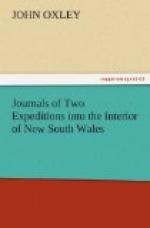“I continued along the banks of the stream until the 8th of July, it having taken during this period a westerly direction, and passed through a perfectly level country, barren in the extreme, and being evidently at periods entirely under water. To this point the river had been gradually diminishing, and spreading its waters over stagnated lagoons and morasses, without receiving any tributary stream that we knew of, during the whole extent of its course. The banks were not more than three feet high, and the marks of flood on the shrubs and bushes showed that at times it rose between two and three feet higher, causing the whole country to become a marsh, and altogether uninhabitable.
“Farther progress westward, had it been possible, was now useless, as there was neither hill nor rising ground of any kind within the compass of our view, which was bounded only by the horizon in every quarter, and entirely devoid of timber, unless a few diminutive gum, trees on the very edge of the stream might be so termed. The water in the bed of the lagoon, as it might now be properly denominated, was stagnant, its breadth about twenty feet, and the heads of grass growing in it showed it to be about three feet deep.
“This unlooked for and truly singular termination of a river, which we had anxiously hoped, and reasonably expected, would have led to a far different conclusion, filled us with the most painful sensations. We were full five hundred miles west of Sydney, and nearly in its latitude; and it had taken us ten weeks of unremitted exertion to proceed so far. The nearest part of the coast about Cape Bernoulli, had it been accessible, was distant above one hundred and eighty miles. We had demonstrated beyond a doubt, that no river could fall into the sea between Cape Otway and Spencer’s Gulf, at least none deriving its waters from the eastern coast; and that the country south of the parallel of 34 degrees, and west of the meridian 147. 30. E. was uninhabitable, and useless for all the purposes of civilized men.
“It now became my duty to make our remaining resources as extensively useful to the colony as our circumstances would allow; these were much diminished: an accident which happened to one of the boats in the outset of the expedition had deprived us of one third of our dry provisions, of which we had originally a supply for only eighteen weeks, and we had been consequently for some time living on a reduced ration of two quarts of flour per man, per week. To return to the depot by the route we had come would have been as useless as impossible; and, seriously considering the spirit of your excellency’s instructions, I determined, after the most mature deliberation, to take such a route, on our return, as would I hoped comport with your excellency’s views, had our then situation ever been contemplated.




